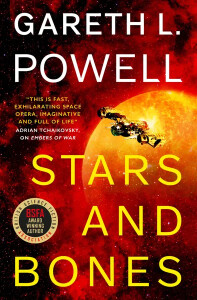 British SF author Powell has begun a new series called Continuance with the action-packed Stars and Bones. It’s packed not just with action but with some intriguing ideas. Powell has created a universe, an FTL travel concept, and a timeline for Earth and its people that are unique among space operas, which is no mean feat.
British SF author Powell has begun a new series called Continuance with the action-packed Stars and Bones. It’s packed not just with action but with some intriguing ideas. Powell has created a universe, an FTL travel concept, and a timeline for Earth and its people that are unique among space operas, which is no mean feat.
The backdrop of the tale is this: Humanity was on the verge of destroying itself and its biosphere with nuclear war. But as the missiles were flying through the air, they suddenly disappeared, along with every other bit of ordnance on Earth, from the tiniest .22-caliber bullet to … well, all those intercontinental ballistic missiles. Turns out we were being observed, for quite some time, by a being that came to be referred to as the Angel of the Benevolence. The huge, amorphous and nearly all-powerful being calling itself Raijin was one of many of its kind, living for millions of years and keeping an eye on emerging civilizations. To make sure they don’t destroy their planet (or anyone else’s). The Angels don’t care of the people of Earth destroy themselves, and they were ready to let humans do that, until a certain scientist succeeded in achieving the quantum feat of teleportation. In the terms of this story, he “accessed the substrate,” which is the interstitial layer where interstellar travel can take place.
So Raijin stopped the extinction of humans, but then ruled that they all had to leave Earth. Every last one, on a fleet of arks it created, that would be humanity’s home forever. No putting down on another planet they could eventually destroy with their selfishness and violence. Earth is left to the non-human species to recover along with the ecosystem and evolve as they will.
We join the Diaspora about three generations later, some 75 years into humanity’s voyage among the stars. When something unexpected and dangerous happens.
The story is told mostly by Eryn, who is a substrate navigator. She and her sentient scout ship Furious Ocelot are among the select few who travel ahead of the Continuance Fleet, scouting out systems and worlds of interest and looking for potential threats. An interesting twist in this Continuance universe is that neither the ship nor the navigator can travel the substrate on their own – both need the other. Certain humans can subconsciously find their way through this nether region, and they team up with a ship mind, who can safely carry humans and others through it.
Eryn’s younger sister Shay is also a navigator. She and her ship Couch Surfer have gone missing, and Eryn, Ocelot (who like most ship minds manifests as a blue-skinned humanoid) and a small crew are going to the planet where they were last seen, known only as C-623. What’s waiting on that planet is unexpected, inexplicable, and horribly violent, and Eryn, a humble navigator, ends up heading the effort to save exiled humanity from it.
As I said, it’s an interesting – at times gripping – tale. It has strong elements of horror as well as space opera, plus even a brush with fantasy. The antagonist turns out to be somewhat like the “protomolecule” in the popular TV and book series The Expanse,” and just as tenacious and unpredictable.
Along the way I discovered I’m not a big fan of Powell’s prose style, which to me is frequently clunky, especially in external and internal dialog. I found myself wishing his editor had worked harder to turn sections that sound to me like they were written by an IT nerd into something a little more streamlined and realistic. However, Powell has tons of fans and is a winner of British Science Fiction Association awards, so your mileage may vary. In his acknowledgements, Powell notes that his tale of a humanity-destroying plague written during a pandemic was a difficult feat, and I certainly salute all writers, musicians and other artists who have soldiered on in this difficult time.
Learn more at the Titan Books website.
(Titan, 2022)
